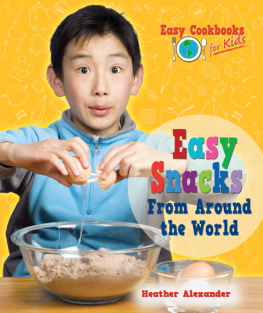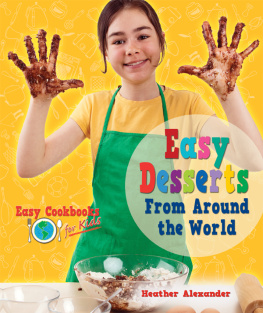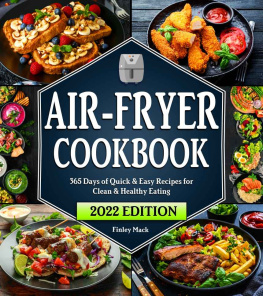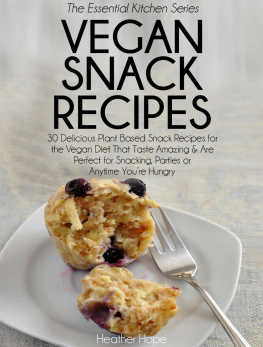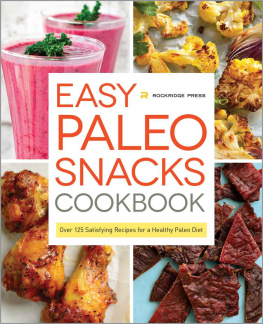Cook yummy snacks from around the worldits easy!
Have you ever tried bruschetta? How about Caribbean fruit smoothies? If you enjoy trying new foods and learning about the countries they come from, this book is for you!
Not only will young readers enjoy reading the books in this series, but they will also want to make some of the recipes that fill the pages.
Allan A. De Fina, PhD
Past President of the New Jersey Reading Association
Chairperson, Department of Literacy Education
New Jersey City University
Jersey City, New Jersey
Cooking for me isnt just a career, its my passion. Every day I learn something newits about having fun and being creative.
Jenna Maruszak
Culinary Institute of America Alum 2007
Banquet Chef at Indian Trail Club
Franklin Lakes, New Jersey
About the Author
Heather Alexander is an award-winning author of over twenty books for children. She loves her role as official taste tester when her two daughters take to the kitchen to cook, bake, and create.
Warning: The recipes in this book contain ingredients to which people may be allergic, such as peanuts and milk.
Have you ever met a kid from another country? Maybe youve seen pictures of kids from around the world. They probably seem very different from you. They may wear different clothes, speak a different language, or live in a different kind of house. But no matter what part of the world kids live in, they all get hungryespecially between meals. Snack time is a great time to have fun in the kitchen cooking something delicious to eat.
Food brings the world together. It tells a story about each country. Food can tell you about the countrys climate and history, about the ingredients that are grown there, and about the way its people live. Cookingand eatingare a fun and yummy way to learn about other cultures.
This cookbook has eleven recipes from eleven different countries or regions. When you follow a recipe, you can read about the country the dish comes from and the unique ingredients that flavor it.
Each recipe in this book has directions on What You Need, which lists the equipment and ingredients for the recipe, and a section called Lets Cook!, which tells you what to do. You will also find information on ingredients and techniques used.
So tie on an apron and lets cook easy snacks from all over the world!

Image Credit: Shutterstock.com
Whenever you are in the kitchen, there are important safety rules to follow.
1. Always ask a responsible adult for permission to cook. Always have an adult by your side when you use the oven, the stove, knives, or any appliance.
2. If you have long hair, tie it back. Remove dangling jewelry and tuck in any loose clothing.
3. Always use pot holders or oven mitts when handling anything on the stove or in the oven.
4. Never rush while cutting ingredients. You dont want the knife to slip.
5. If you are cooking something in the oven, stay in the house. Always use a timerand stay where you can hear it.
6. If you are cooking something on the stove, stay in the kitchen.
7. ALLERGY ALERT ! If you are cooking for someone else, let them know what ingredients you are using. Some people have life-threatening allergies to such foods as peanuts, dairy products, and shellfish.
- Wash your hands before you start. Make sure to also wash your hands after touching raw poultry, meat, or seafood and cracking eggs. These ingredients may have harmful germs that can make you very sick. Wash knives and cutting boards with soap and water after theyve touched these ingredients.
- Use two cutting boards (one for meat and one for everything else) to avoid getting any germs from the meat on other food.
- Rinse all fruits and vegetables under cool water before you use them.
- Make sure your work space is clean before you start.
- Clean up as you cook.

Image Credit: Shutterstock.com
- Read the recipe from beginning to end before you start cooking. Make sure that you have all the ingredients and tools you will need before you start.
- If you dont understand something in a recipe, ask an adult for help.

Image Credit: Shutterstock.com
- To measure dry ingredients, such as flour and sugar, dip the correct size measuring cup into the ingredient until it is full. Then level off the top of the cup with the flat side of a butter knife. Brown sugar is the only dry ingredient that should be tightly packed into a measuring cup.
- To measure liquid ingredients, such as milk and oil, use a clear glass or plastic measuring cup. Make sure it is on a flat surface. Pour the liquid into the cup until it reaches the correct level. Check the measurement at eye level.
- Remember that measuring spoons come in different sizes. Be sure you are using a teaspoon if the recipe asks for it and not a tablespoon .
- Beat Mix ingredients together fast with a wooden spoon, whisk, or an electric mixer.
- Mix Blend ingredients together with a wooden spoon, an electric mixer, or a whisk.
- Stir Combine ingredients together with a wooden or metal spoon.

Image Credit: Shutterstock.com
- Cracking an egg Hold the egg in one hand. Crack the eggshell against the side of a bowl. Using both hands, pull the eggshell apart over the bowl so the yolk and the white drop into the bowl.
- Cooling After food has been baked in the oven, place it on a wire rack until it is no longer hot.
- Preheating Turn the oven on at least 15 minutes before you need to use it.
- Warming ingredients When a recipe says an ingredient should be at room temperature, take it out of the refrigerator for a while until it is no longer chilled.
- Greasing a pan Spread butter, margarine, shortening, or oil over a baking pan or cookie sheet using a small piece of waxed paper. Or use a spray-on oil. It is often easier (and less messy) to cover a cookie sheet with parchment paper instead. You can find parchment paper in the baking aisle of your market.
- Greasing and flouring a pan Grease a pan as described above. Then pour 1 or 2 tablespoons of flour onto the pan and shake it around so the entire surface is covered. Then hold the pan upside down over the sink or garbage can and tap the back of the pan gently so that the extra flour falls out.
Cooking has its own vocabulary. Here are some terms you should be familiar with.
chop (verb) To cut into bite-sized pieces.
cuisine The type of cooking used in a particular country or region.
dice (verb) To cut into small pieces (smaller than chopped).
garlic bulb A head of garlic, containing a number of smaller pieces, or garlic cloves.

